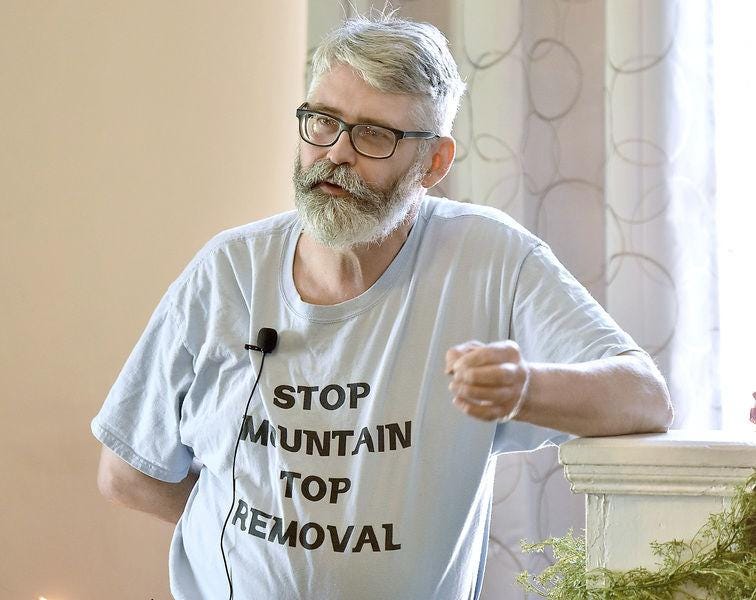Mountaintop removal
“Mountaintop removal is really hard to comprehend. It is so alien to the human experience.” Vernon Haltom’s words are measured, possibly from explaining his work many times before. “When I first heard the term mountaintop removal, I didn’t think that it was something that bad. I just thought it was taking the very top off of a mountain. But mountaintop removal mining is like going to the barber and asking that a little be taken off the top and then you wind up being decapitated.”
Vernon Haltom is the Executive Director of Coal River Mountain Watch (CRMW), a nonprofit that has worked to end the practice of mountaintop removal coal mining (MTR), concentrating much of their efforts to save the mountains and hills around the Coal River in the southern part of West Virginia.
Haltom might be thought of as exaggerating, but he is justified in conveying the enormity of MTR. The mines are so large they dwarf the nearby towns. “It destroys everything in the mountains and forests. First they clear-cut the trees. They are burned or buried. You have trees that are four foot in diameter that are being burned or buried. Then they bulldoze the understory. That includes all the ginseng and mushrooms. Everything is blasted to smithereens.”
All the earth removed from the mountain is dumped into adjacent valleys and streams. As of 2012, over 2,400 miles of streams had been buried by mountaintop mining. The runoff from the mines contains heavy metals and sulfuric acid, which kills the biota of the remaining streams.
Getting the word out
CRMW informs the public about the ravages of mountaintop removal, getting the word out through op-eds in regional newspapers,1 and getting their work covered in national and international press.2 CRMW has sponsored events to raise awareness of the mining practice.3 They have beseeched state representatives and governors; they have knocked on the doors of Congresspersons. In 2013 the organization helped focus the attention of United Nations on the human rights abuses connected with MTR.
Most dramatically, in September 2010, thousands marched on the White House to persuade Washington to curtail MTR. The “Appalachia Rising” movement had a sit-in at the offices of the Army Corps of Engineers, the government agency that writes permits for the mining companies to dump mine waste into streams. Demonstrators formed outside the offices of the EPA and PNC Bank, which finances many of the mining projects. More than 100 individuals were arrested.4
The work of CRMW has been highly recognized. Judy Bonds, a leader of CRMW was awarded the Goldman Environmental Prize in 2003. Maria Gunnoe, a former CRMW advocate, has received the Callaway Award, Rainforest Action Network’s David vs. Goliath Award, and the prestigious Raoul Wallenberg Award. Haltom and his wife were recognized with the Linda Schnautz Environmental Courage Award from the WV Environmental Council in 2010. Originally from Oklahoma, Haltom moved to West Virginia because his wife has roots in the Mountain State.

Big blasts and bad health
Explosives are used to blow up the mountains. Haltom says that some of the blasts have the force of the largest nonnuclear military bombs, the ones they call “mother of all bombs” used in Afghanistan. Communities in mountaintop mining areas will experience these blasts every day of the week except Sunday. In 2017, National Resources Defense Council Senior Attorney Bobby Kennedy, Jr., said that the amount of explosives used in mountaintop mining is equal to dropping a Hiroshima-sized bomb in the Appalachian Mountains every week.
The first drone video of a mountaintop mining blast was in November of last year. “That’s the first time that I know of that anyone directly measured the distance that the dust travels from a mountaintop removal blast. That dust traveled for more than two miles. That contains mostly silica and we’ve known for a hundred years what that does to people when they breathe it.”
When Haltom speaks of the long-known hazards of silica dust, he is referring to the Hawks Nest Tunnel Disaster, when workers were exposed to silica dust as they bored a tunnel for a Union Carbide hydroelectric project near Hawks Nest, West Virginia in the 1930s. Many workers developed silicosis, a condition in which the lungs are scarred by the dust. It inhibits a person’s ability to breath. Hundreds of the men who worked in the tunnel died of the disease.
Babies born to women who live close to mountaintop mines have a higher rate of birth defects.5 People who live around the mines are more prone to depression. Health investigations have found learning disabilities, kidney stones, tooth loss, diarrhea, rash, and some forms of cancer in individuals living close to Mountaintop mines.6
For Haltom, the toll is real. Judy Bonds died of cancer in 2011. Another advocate, Larry Gibson died of heart disease in 2012. Haltom ticks off names of others whose lives have been cut short from living around the mines. “And more people I didn’t know personally, or who lived near MTR elsewhere,” he says. “More than 1,200 people die every year, excess deaths, related to MTR.”
The fight continues
Haltom and CRMW fight the misconception that mountaintop removal has ended. “A lot of people think Obama ended mountaintop removal. Obama did not end mountaintop removal.” The myth is even propagated by environmental organizations. One group opened a 2016 fundraising flyer with “Mountaintop removal is essentially over.”
Haltom says that the decreased demand for coal, mountaintop mining has lessened, but it still continues. “They are trying to get a permit for a fourth mountaintop mine less than one mile from Clear Fork Elementary. Another active permit is only two miles from the new Marsh Fork Elementary School, although they haven’t gotten to that point yet.”
A recent video of the mines around Coal River in West Virginia.
Through the 23 years of Coal River Mountain Watch’s advocacy, Haltom feels that he can count few successes. CRMW got clean water for the folks who live in Prenter, West Virginia, after a mountaintop mine contaminated their well water. The organization was successful in getting a primary school moved away from an earthen dam that holds 2.8 billion gallons of mining waste. The film On Coal River documents this years-long struggle as individuals pushed local, and state officials, and even went to Washington D.C. with their plight.
The work of CRMW is also dangerous. Haltom and others who work with CRMW continue to be on the receiving end of violence and death threats. Judy Bonds was sucker punched in the face during a protest by a coal mining supporter. Maria Gunnoe’s dog was shot and killed. Recently, another CRMW supporter, Junior Walk, had his brake lines cut. “The mine companies know that they can turn neighbor against neighbor,” says Haltom. “We get heckled and harassed on our way into meetings for comments.” He has heard people say, “We know who you are. We know where you live, and you better not sleep at night.”
As my conversation with Haltom winds up, he remains upbeat, a bit surprising after talking about ecological damage and violence. “It can be daunting when you have everybody from the governor to the janitor against you. But we’re in it for the long haul,” he says. “If you can save a life, it’s worth it. You may not know who that person is, but it’s worth it. If you can keep one baby from being born with a birth defect, it’s worth it.”
For more environmental news follow me on Twitter @EcoScripsit.
UPDATE: 9/28/2021
Corrections: Drone videos of mountaintop mines have been made before November of last year, but the November video is the first to show how far a silica dust cloud travels. Here is the video:
In Prenter, West Virginia, MTR may have contributed to the contamination of the resident’s well water. The greatest contaminating factor was the coal companies pumping processed mining waste sludge into abandoned underground coal mines, where it then seeped into the aquifers of the wells.
Maria Gunnoe received her awards while she was with the Ohio Valley Environmental Coalition, not Coal River Mountain Watch.
"Razing Appalachia King Coal is Lopping Off Mountains." Roanoke Times [VA], 28 Oct. 1999, p. A19. Gale OneFile: News, link.gale.com/apps/doc/A70857525/STND?u=sddp_main&sid=bookmark-STND&xid=909043f0. Accessed 17 Sept. 2021.
Paul Harris "They flattened this mountaintop to find coal - and created a wasteland: A ravaged US state is fighting back against mining bosses who backed Bush." Observer [London, England], 16 Jan. 2005, p. 25. Gale OneFile: News, link.gale.com/apps/doc/A127164872/STND?u=sddp_main&sid=bookmark-STND&xid=9c12cc78. Accessed 17 Sept. 2021.
"Mountaintop Removal Mining Awareness Events Scheduled." Roanoke Times [VA], 29 Sept. 2004, p. NRV9. Gale OneFile: News, link.gale.com/apps/doc/A122644480/STND?u=sddp_main&sid=bookmark-STND&xid=5e3377b3. Accessed 17 Sept. 2021.
"More Than 100 Arrested at White House Demanding End to Mountaintop Removal." States News Service, 27 Sept. 2010. Gale OneFile: News, link.gale.com/apps/doc/A240733898/STND?u=sddp_main&sid=bookmark-STND&xid=4bc45ba0. Accessed 26 Sept. 2021.
Ahearn, Melissa M. et at. “The association between mountaintop mining and birth defects among live births in central Appalachia, 1996–2003.” Environmental Research Vol. 111 Issue 6. Aug 2011, p 838-846 print.
Holzman, David C. “Mountaintop Removal Mining.” Environmental Health Perspectives Vol. 119, Issue 11 November 1, 2011 electronic journal




